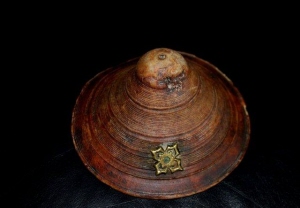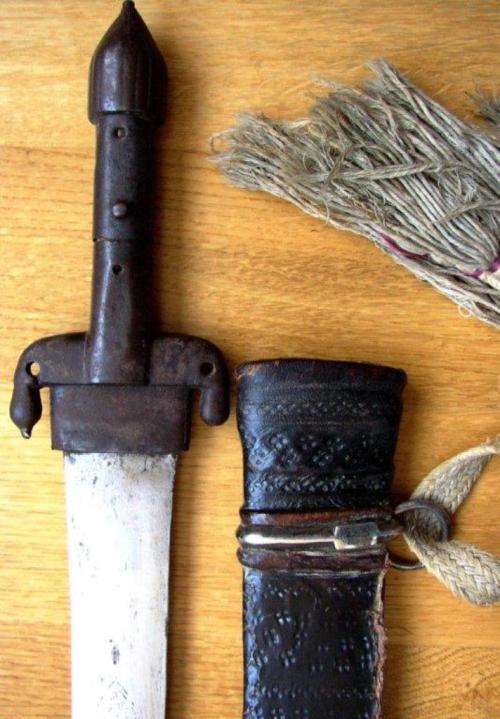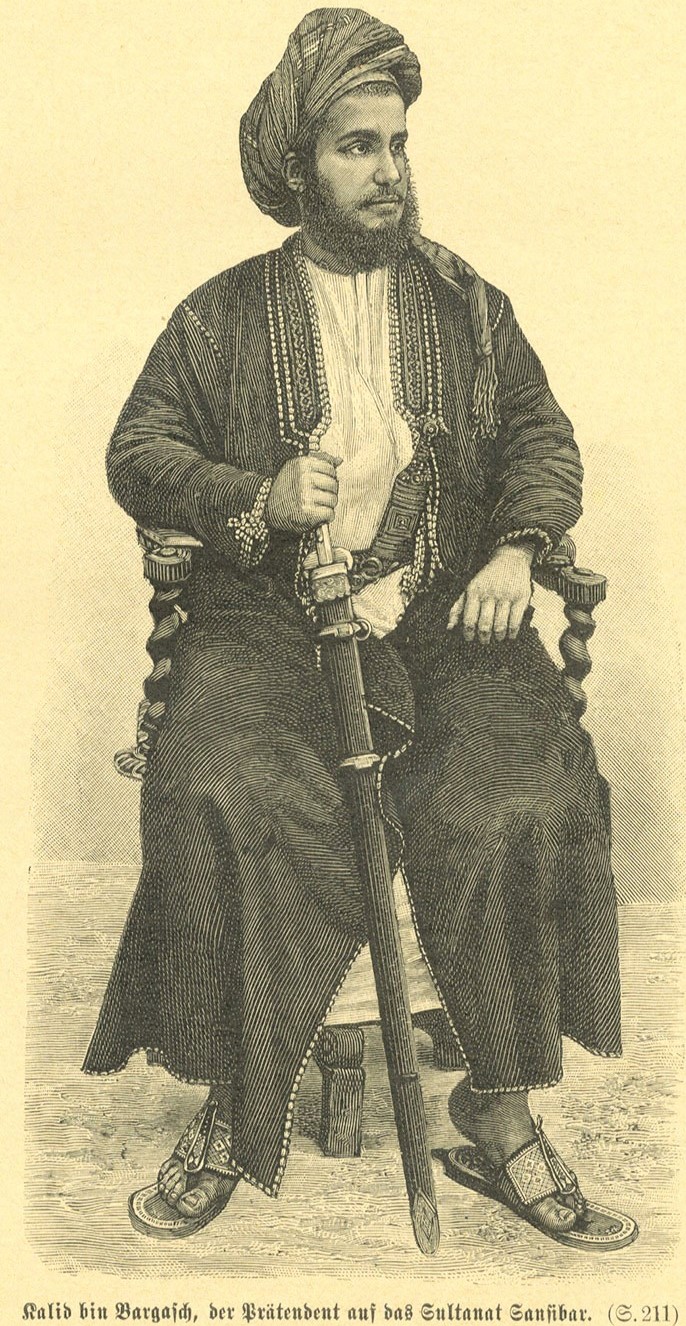 |
|
Antique Omani shield buckler
|
Below you find our collection of swords, shields and sword ornaments. Little is known on the subject of Omani swords. The best book on this topic is still the book Arms and Armour of Arabia by Elgood. We have distilled some relevant texts from old publications on Oman and Zanzibar. We can conclude that during the 17th century there were already Omani sword and gun makers but that by the early 19th century these were probably foreigners. Also that European blades were already popular in the 17th century . Very characteristic are the Omani Rhino-skin shields, they are very strong and have probably been made in Zanzibar in the 19th century. They are already shown on a French painting from around 1840. Wellsted in his "Travels in Arabia (Ref 6) " 1838 writes on page 348-349: "That their shield measures about fourteen inches in diameter, and is usually attached by a leather thong to the sword. The best kind , made from the skin of the hippopotamus, are brought from Abyssinia. Their sword is a straight double edged thin blade about three feet in length, having a long handle, without any guard" Ingrams in His Zanzibar (Ref 1 ) 1930 page 326 "Colonel Sykes (Climate and productions of Zanzibar 1850) says: One branch of manufacture is carried to a considerable extent, that of round shields 18 inches in diameter made from the hide of a rhinoceros, which after being soaked and boiled , can be moulted into any form. Comment: diameter of shield slightly wider than the "Turs" , however could alternatively be the Baluchi shield as that is also made of thick hippopotamus or Rhino leather. Wellsted writes in 1838 8 (Ref 6) page 17. " In Oman people from Bundar Abbas, Lar and Menon manufacture swords and matchlocks, for which there is a great demand from the interior of Oman" In 1672/1673 a Dutch VOC ship visits Muscat and a Dutchman named Padttbrugge reports on what he sees in Muscat (see Ref 4 first item) : "They normally wear their sword on a bandoleer over the left shoulder. The scabbard has 2 rings: one just below the hilt, the other in the middle. Connected to the rings is the bandoleer in order that the sword can be worn horizontally. The hilt has light silver work. The scabbard has silver-work, the amount depending on the spending power of it´s owner. The blade is broad and straight and has the shape of a half-broad sword. The sword is rather heavy and not flexible (this is why they prefer our (Dutch) blades that have the same shape) Some , especially under the more common folk, have Turkish curved swords, which they (the Omani) do not prefer. You find a lot of Arab gun-makers and sword makers. Also canon bullet-smiths because they do not know how to melt and cast iron." Comment: "The more common people" could be the Baluchi. Franz Stuhlmann in his book "Handwerk und industrie in Ost Afrika Hamburg 1910" mentions that the swords of the Baluchi are typically made of Damaskus steel while Omani swords are made of regular steel.
The physician of Said bin Sultan, the Italian Vincenzo Maurizi, writes in his book History of Seyd Said Sultan of Muscat (published in London by John Booth 1819) page 135/136: "The arms of the Omani Arabs consists of a long lance and a sabre, the shield is made of the a whale or large fish (=probably rhino) about the thickness of a finger, united to the sword by the girdle, and in form much resembles the plates out of which the Italian peasantry eat their pottage! Their strength is so great as almost turn a cannon ball, the fire arms are generally matchlock. But thee were only 500 of these clumsy weapons. in the 5000 men commanded by Matlk., Seyid Said has lately procured pistols from Bombay and has armed all his cavalry with them. In time of peace the Sultan and the Jemadar of the Beluchi carry bucklers very richly ornamented; but in the day of battle these make way, for the more useful though less means of defence above described"

According to Pearce Zanzibar 1920 Ref 3 page 229 : "the swords can be of great age and are regarded as heirlooms. Not infrequently the blades are of old Portuguese or Spanish Manufacture.There are three types of swords used by the (Omani) Arabs:
- Saif, Sef Franji or felegi: Is a straight broad two edged weapon without a guard. It is about 4 feet and 3 inches long and can be used with both hands The handle is bound with plaits of black leather and real gold and silver ribbon forming a check pattern. These are the swords , the blades of which may be of European manufacture, as the name Franji (Franks) implies. (All western Christians were called Franji by the Saracenes from an early date)
- The second kind is the kittareh (should be shamsir) , a sabre with a curved blade, and generally of Persian or Indian workmanship.
- Yemeni (??) This is a cross-hilted short-bladed weapon , which is comparatively rare in Zanzibar. As the name implies it is manufactured in Arabia, although it is possible that some of the blades may have been brought to the East by the Crusaders. "
Emily Ruete writes in her Memoirs of an Arabian Princess 1886:
"To the retinue of every lady who went out also belonged a whole troop of armed slaves, who looked more martial than they really were. These people always were costly, because the weapons, were all richly inlaid with gold and silver and are expensive indeed. But that did not prevent the rascals from selling them for a slice of bread or from pawning them for a trifle at some usurer's (these fine people usually are Hindus or Banyans),because the frivolous fellows wanted to quench their thirst with pombe (palm wine) In such cases there was nothing for the mistress to do but to ransom the weapons at a tenfold rate, or furnish the fiend with new equipment along with a well-deserved chastisement as a warning;
"In the gentlemen's rooms the walls are decorated by trophies, consisting of all kinds of costly weapons from Arabia, Persia and Turkey"

Kalid bin Barghash of Zanzibar with ancient Kattara

Omani sword dance in the 1990's